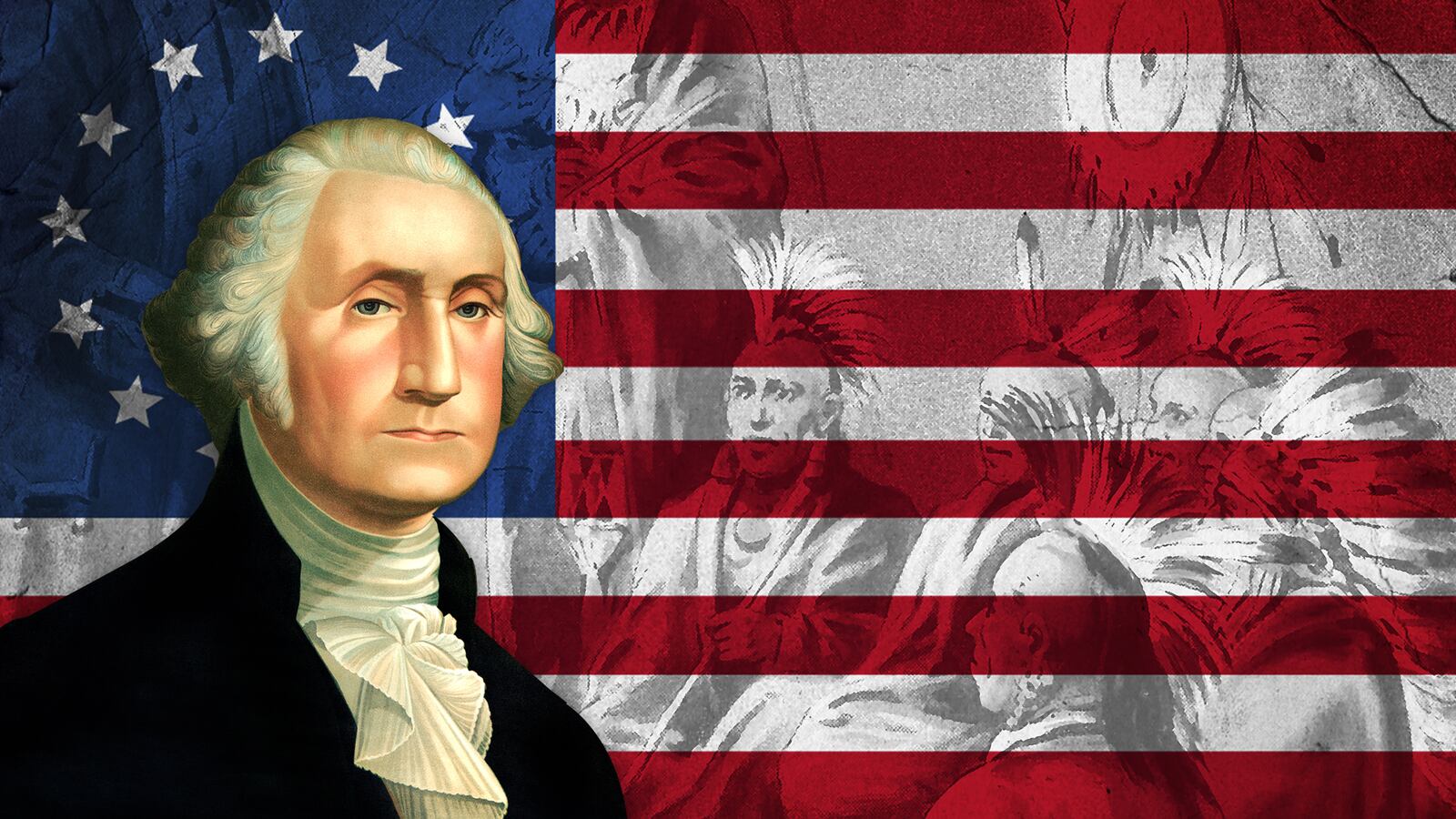It took eight long years of war to establish the 13 American colonies as an independent nation. Whether the American experiment would flourish in its early years depended far more than we commonly recognize on the new republic’s ability to establish viable relationships with several powerful Indian confederacies west of the Allegheny Mountains that formed the great frontier. These polities stood directly in the path of American civilization’s inexorable march westward across the continent that the founding fathers understood to be the new nation’s destiny.
The future of America, President George Washington believed deep in his bones, lay in the west, not in its transatlantic relationships. Diplomacy with the Indians probably occupied more of the first president’s time and energy than any other issue during his first term. Indian chiefs and their retinues were frequent dinner guests at the president’s residence. Washington assiduously respected Native American diplomatic protocol by engaging in gift exchange and smoking a long-stemmed pipe with his guests in a sacred commitment to speak truth in conference negotiations, and to honor pledges made.
As Colin G. Calloway makes clear in his provocative and deeply researched new book, The Indian World of George Washington, the task of negotiating these arrangements was exceedingly complicated. Many of these tribes had fought with the British during the Revolution. The Brits had ceded the enormous territory between the Alleghenies and the Mississippi River to the United States in the Treaty of Paris (1783), but the Indians were not about to relinquish vast swaths of their homelands to the victors just because London had thrown in the towel. The Indians west of the frontier had not suffered military defeat; nor did the Treaty of Paris reflect the realities of military strength beyond the Ohio River.
The new federal government’s ability to regulate the westward flow of white settlement was strictly circumscribed by a lack of funds and the extraordinary pressures of a rapidly growing population. The states on the frontier line resisted tenaciously the federal government’s effort to manage Indian affairs. They were eager—even desperate—to obtain additional land, and were more than willing to resort to rapacious means to get it.
Many of the tribes were militantly independent and did not trust the new “Great Father.” During the Revolution, Washington had ordered the Continental Army to raze Seneca, Onondaga, and Cayuga villages because of their alliance with the British. Forty villages and 160,000 bushels of corn had gone up in smoke, and Washington earned a new sobriquet: Conotocarious, which means “destroyer of villages.”
But the new president had been there at the start of the struggle for the American interior. He’d developed an intimate knowledge of Indian-white politics and diplomacy as a young man when he was a surveyor on the frontier, and later as a commander of a joint force of Seneca warriors and Virginia troops in the French-Indian Wars. Like virtually all 18th century Americans, he thought Indian culture was backward and inferior to European civilization. But unlike most Americans, he respected Indians as human beings, recognized they had rights, and wanted to treat them fairly and decently.
The first chief executive was unquestionably sincere in exclaiming at the beginning of his first term that “the administration of Indian affairs shall be directed entirely by the great principles of justice and humanity… Indians being the prior occupants, possess the right of the soil… To dispossess them… would be a gross violation of the fundamental laws of nature and of that distributive justice which is the glory of a nation.”
Washington was ready and willing to provide the tribes with ample compensation for their territory in the form of annuities and other concessions. And he wisely insisted on treating the Indians as foreign nations, as the Constitution granted him rather than the individual states the leading hand in negotiating treaties with other powers.
Moreover, Washington was well aware that many Indian chiefs now viewed him as their personal protector against the looming tidal wave of westward white settlement. “Brother,” wrote one Cherokee leader to GW, “we give up to our white brothers all the land we could any how spare, and have but little left… and we hope you won’t let any people take any more from us without our consent. We are neither birds nor fish; we can neither fly in the air nor live under water.”
Accordingly the president worked tirelessly to establish sovereign Indian “homelands” that were strictly off limits to white settlers or unlicensed traders. As white settlements approached Indian lands, game would inevitably diminish, and the Indians, being largely hunters, would be glad to sell off additional parcels and move farther west.
That, at least, was the theory.
In the summer of 1790, Washington hosted a charismatic Creek statesman by the name of Alexander McGillivray and 26 other chiefs for several weeks of official dinners and other ceremonies in New York City. The result was the Treaty of New York, which established a Creek Nation on the southern frontier and opened up vast new territories for American expansion. Soon thereafter, Washington issued the Proclamation of 1790, an executive order that forbade private citizens, corporations, or states from encroaching on Indian lands.
Washington’s noble efforts were foiled in one of many conflicts between the federal government and the states over Indian territory when Georgia defied the treaty and the proclamation, and sold 15 million acres on its western border to a speculating company, leading to vicious fighting between the Creeks and white frontiersmen.
In the Ohio valley of the Northwest Territory, there had been more or less ceaseless fighting between whites and Indians since the end of the Revolutionary War. Washington believed the settlers were largely to blame. They had provoked hostilities with the Miami and Shawnee, and it troubled him deeply. He ordered the new U.S. Army to put down the violence, but once again, his efforts to bring peace ended in an orgy of killing.
General Arthur Sinclair’s expedition was ambushed and almost completely annihilated near present day Fort Recovery, Ohio in November 1791. More than a thousand warriors under Little Turtle and Blue Jacket killed 600 soldiers and wounded 200 in a brilliantly executed surprise attack.
Other defeats followed, prompting a huge public outcry for reprisals against the Indians in what historian Joseph Ellis calls “an escalating cycle of violence that defied Washington’s efforts at conciliation.” Finally, Washington sent an elite Army force under Gen. Anthony Wayne to bring a definitive end to the Northwest Indian War—the first war ever fought by the U.S. Army. Wayne’s force attacked the Western Confederacy at the Battle of the Fallen Timbers in August 1794, and the Indians were decisively defeated.
In the Treaty of Greenville (1795), the Western Confederacy was forced to cede most of present-day Ohio and part of Indiana, as well as the sites of Detroit and Chicago, to the United States. The Greenville boundary line, observes Calloway, “proved no more effective in checking American expansion than the Proclamation Line of 1763,” which had prohibited all white settlement from the entire region between the Alleghenies and the Mississippi River.
By 1796, a much discouraged Washington had begun to doubt that the federal government had the capability to establish a lasting and fair peace with the Native peoples. The flow of settlers to the west was simply too powerful to contain. “I believe scarcely anything short of a Chinese wall or a line of troops will restrain land jobbers and the encroachment of settlers on Indian territory,” he wrote wistfully.
Aggravating an already difficult situation was the Indians’ public relations problem. No one heard their side of the story. As Washington lamented, the “poor wretches have no press thro’ which their grievances are related; and it is well known, that when one side of a story is heard, and often repeated, the human mind becomes impressed with it, insensibly.”
Nonetheless, Washington continued to work earnestly for peace and justice in Indian affairs. With his Secretary of War Henry Knox, he put forward an assimilationist policy. The Indians should be educated and socialized to become like Americans, giving up their hunting rifles and horses for plows and farms. Federal agents would supply them with farming tools and cattle, and they would be taught reading, writing, and arithmetic. Washington saw these policies, says Calloway, “as setting Indians on the road to survival, not destruction, giving them the opportunity to remake themselves as American citizens.”
If expansion was inevitable, the only way to prevent the demise of the Indians was convince them to abandon their traditional culture and adopt the American way of life. But the new policies, in the end, says Calloway, “could not compete with the human and economic forces arrayed against them.” Most but not all tribes rejected the notion that they could be “improved” through the “gifts” of Christianity and civilization, and the frontier pressed forward relentlessly, in a series of brutal and costly wars.
Professor Calloway joins all Americans except for a few reactionary cranks in seeing this as a sordid and regrettable chapter in the American story, but he reminds us of an important and redeeming truth. The Indians never did give up their identity as Indians. They adapted some aspects of the assimilationist policies, and rejected others. They kept their sacred beliefs and many of their customs and rituals, “maintaining an unchanging core beneath the surface of change… Indian societies shuddered under the shock of assault, and then held.”
Washington’s effort to protect Indian societies from the predations of white civilization and to treat them fairly was sincere and deeply felt, yet as Calloway concludes, the first president’s commitment to the expansion of American “civilization” proved far stronger in the end than his commitment to justice for the Indians on the frontier.
The father of our country died in 1799 owning several hundred thousand acres of land in erstwhile Indian country. Thus, he himself contributed to the great tragedy he hoped to avoid. And it was on Washington’s watch that the regrettable American tradition of trying to force other cultures to accept our beliefs and institutions was born.

